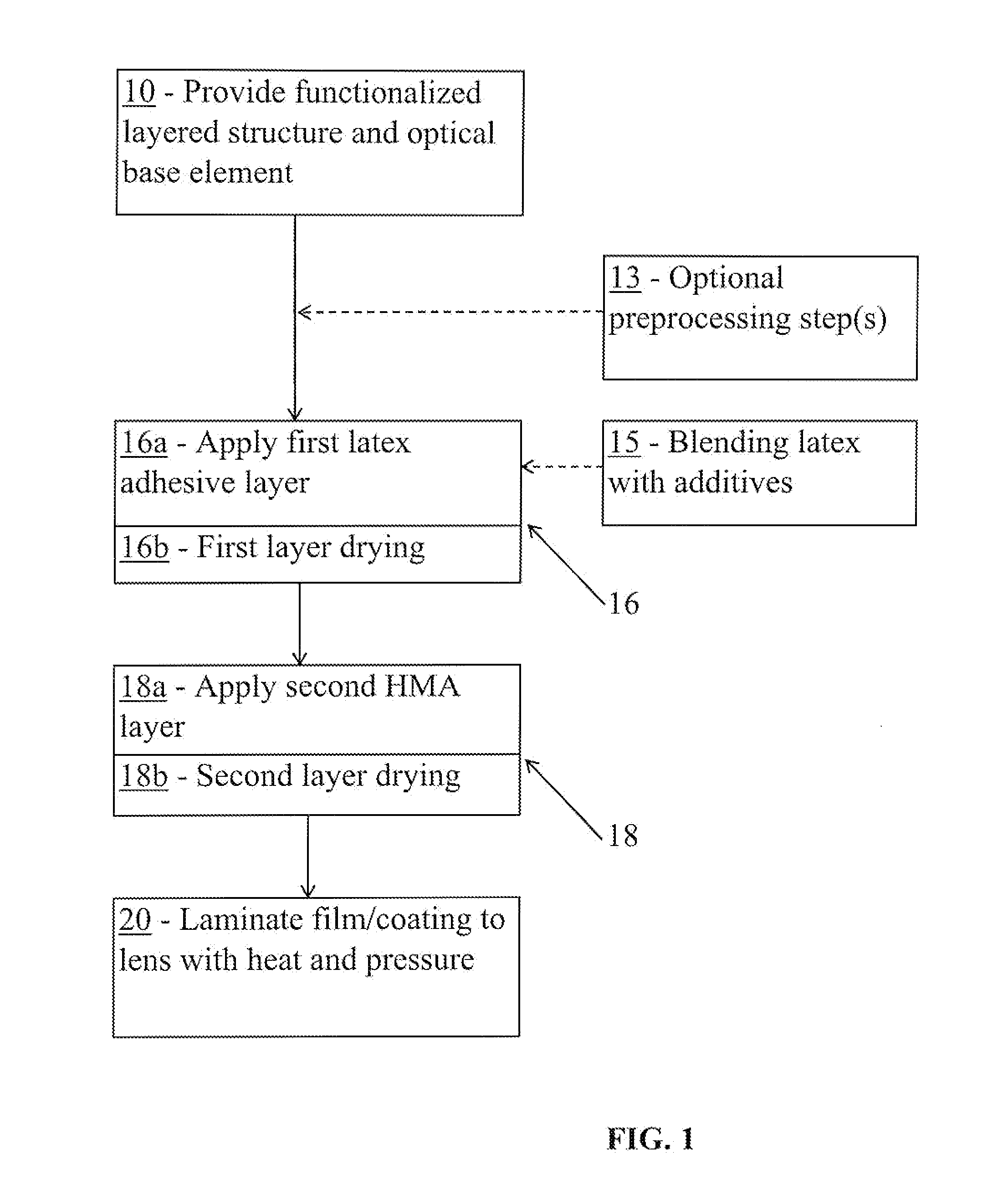Bi-layer adhesive for lens lamination
a technology of bilayer adhesive and lens, applied in the direction of lens, film/foil adhesive, polarizing element, etc., can solve the problems of low adhesion, polarized film and plastic lens adhesion has been a long-standing problem, and the technique previously disclosed has a number of drawbacks, so as to improve the mechanical and optical properties of laminated functional optical elements.
- Summary
- Abstract
- Description
- Claims
- Application Information
AI Technical Summary
Benefits of technology
Problems solved by technology
Method used
Image
Examples
examples 1 & 2
[0044]Adhesion comparison test on TAC / PVA / TAC film between a urethane latex based on W-234 from Baxenden and HMA-U42: TAC film was corona treated firstly, then the films were spin coated with either the urethane latex solution or U42 in the spin conditions of 450-500 rpm for 3-5 seconds and 1000-1500 rpm for 8-10 seconds and then dried at 60 degrees C. for 10-30 min. After drying and cooling, the adhesion behavior on TAC film was measured by classic crosshatch tape method as shown in the following Table 1. The result showed that Latex has better adhesion score than HMA on a TAC film.
TABLE 1Adhesive test on TAC polarized filmCrosshatch TapeEx.AdhesivesFilmTreatmentCoatingadhesion scoreEx. 1LatexTACCoronaSpin and dry0Ex. 2HMA / U42TACCoronaSpin and dry5* Crosshatch tape score 0 means perfect adhesion between Latex and TAC film and 5 means adhesion failure between U42 and TAC.
example 3
[0045]A TAC polarized film (TAC / PVA / TAC) from Onbitt company was first thermoformed to a curve close to the front side of a polycarbonate lens. The convex side of the TAC film is subjected to a corona discharge using Tantec equipment. A urethane latex adhesive based on W-234 from Baxenden is spin coated onto the treated film surface, and set to dry for 30 minutes at 60 degrees C. Next, an HMA solution of Dispercoll® U 42 is spin coated on top of the dried latex layer, and set to dry for 10 minutes at 60 degrees C. The dried bi-adhesive layer was then set against a polycarbonate lens, utilizing an accumulator device having a lens support and an inflatable silicon membrane. The pressure was slowly increased to 30 psi to achieve full contact across the entire surfaces of the film and lens. The accumulator set-up was place in an oven at 80 degrees C. for 30 minutes.
[0046]After lamination the polarized optical element exhibited very strong adhesion between the film and the lens. No delam...
example 4
[0048]Example 3 was repeated except the lamination step was conducted by using a small hot press device with a pressure of 26 psi and heating at 90 degrees C. for 5 minutes. The resulting functionalized optical element had the same good adhesion between the functionalized layered structure and the optical base element. In the peel test a force of 20N was recorded to peel the film at 2.54 mm / min.
PUM
| Property | Measurement | Unit |
|---|---|---|
| thickness | aaaaa | aaaaa |
| thickness | aaaaa | aaaaa |
| thickness | aaaaa | aaaaa |
Abstract
Description
Claims
Application Information
 Login to View More
Login to View More - R&D
- Intellectual Property
- Life Sciences
- Materials
- Tech Scout
- Unparalleled Data Quality
- Higher Quality Content
- 60% Fewer Hallucinations
Browse by: Latest US Patents, China's latest patents, Technical Efficacy Thesaurus, Application Domain, Technology Topic, Popular Technical Reports.
© 2025 PatSnap. All rights reserved.Legal|Privacy policy|Modern Slavery Act Transparency Statement|Sitemap|About US| Contact US: help@patsnap.com


